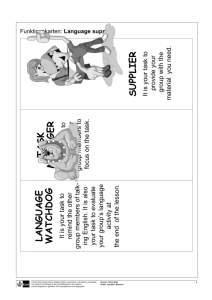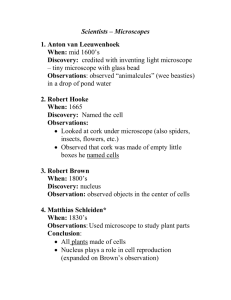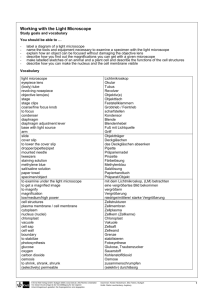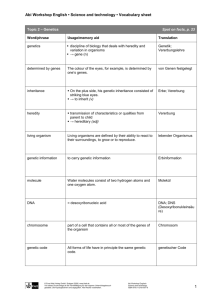Working with the Light Microscope
advertisement
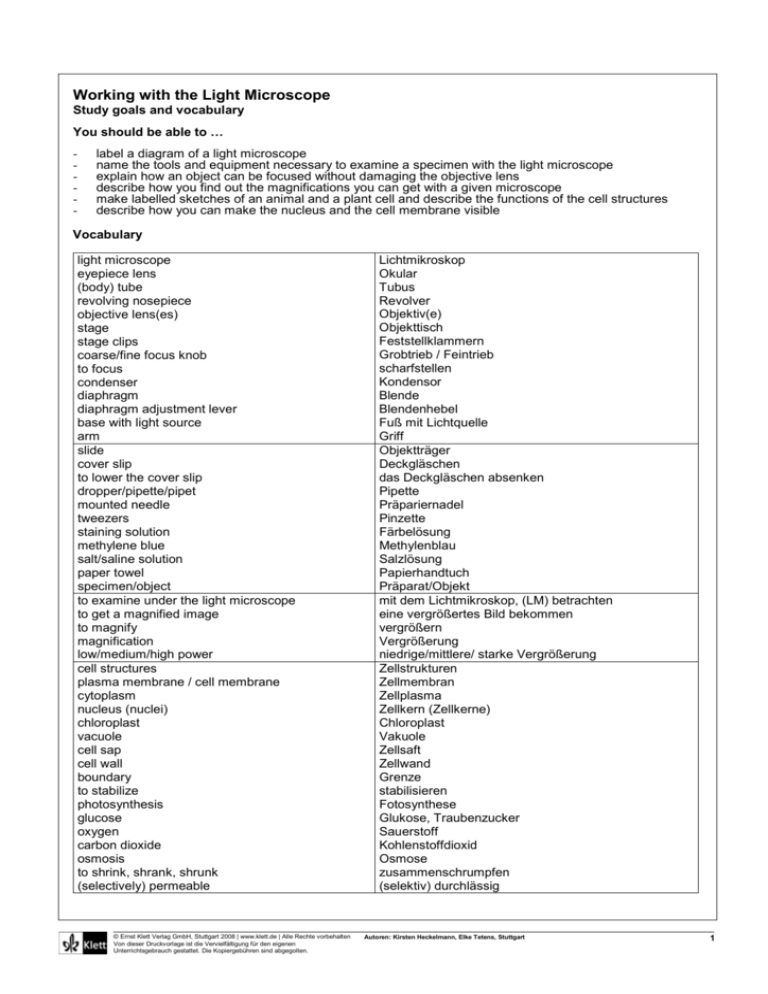
Working with the Light Microscope Study goals and vocabulary You should be able to … - label a diagram of a light microscope name the tools and equipment necessary to examine a specimen with the light microscope explain how an object can be focused without damaging the objective lens describe how you find out the magnifications you can get with a given microscope make labelled sketches of an animal and a plant cell and describe the functions of the cell structures describe how you can make the nucleus and the cell membrane visible Vocabulary light microscope eyepiece lens (body) tube revolving nosepiece objective lens(es) stage stage clips coarse/fine focus knob to focus condenser diaphragm diaphragm adjustment lever base with light source arm slide cover slip to lower the cover slip dropper/pipette/pipet mounted needle tweezers staining solution methylene blue salt/saline solution paper towel specimen/object to examine under the light microscope to get a magnified image to magnify magnification low/medium/high power cell structures plasma membrane / cell membrane cytoplasm nucleus (nuclei) chloroplast vacuole cell sap cell wall boundary to stabilize photosynthesis glucose oxygen carbon dioxide osmosis to shrink, shrank, shrunk (selectively) permeable © Ernst Klett Verlag GmbH, Stuttgart 2008 | www.klett.de | Alle Rechte vorbehalten Von dieser Druckvorlage ist die Vervielfältigung für den eigenen Unterrichtsgebrauch gestattet. Die Kopiergebühren sind abgegolten. Lichtmikroskop Okular Tubus Revolver Objektiv(e) Objekttisch Feststellklammern Grobtrieb / Feintrieb scharfstellen Kondensor Blende Blendenhebel Fuß mit Lichtquelle Griff Objektträger Deckgläschen das Deckgläschen absenken Pipette Präpariernadel Pinzette Färbelösung Methylenblau Salzlösung Papierhandtuch Präparat/Objekt mit dem Lichtmikroskop, (LM) betrachten eine vergrößertes Bild bekommen vergrößern Vergrößerung niedrige/mittlere/ starke Vergrößerung Zellstrukturen Zellmembran Zellplasma Zellkern (Zellkerne) Chloroplast Vakuole Zellsaft Zellwand Grenze stabilisieren Fotosynthese Glukose, Traubenzucker Sauerstoff Kohlenstoffdioxid Osmose zusammenschrumpfen (selektiv) durchlässig Autoren: Kirsten Heckelmann, Elke Tetens, Stuttgart 1 Working with the Light Microscope The parts of the light microscope and their functions Task 1: Identify the following parts of the light microscope • • • • • • • • • • • base and arm on/off switch stage stage clips coarse and fine focus knob eyepiece lens / ocular eyepiece tube revolving nosepiece objective lenses condenser with diaphragm adjustment lever light source - support the light microscope - provides power - holds the slide with the object - hold the slide - move the stage up/down to focus the object - the lens you look through - holds the eyepiece lens - holds the objective lenses - magnify the specimen - regulates amount of light passed through object - provides light Task 2: Label the diagram of the light microscope. Add the German terms in brackets. Task 3: Determine the magnifying powers of your microscope. © Ernst Klett Verlag GmbH, Stuttgart 2008 | www.klett.de | Alle Rechte vorbehalten Von dieser Druckvorlage ist die Vervielfältigung für den eigenen Unterrichtsgebrauch gestattet. Die Kopiergebühren sind abgegolten. Autoren: Kirsten Heckelmann, Elke Tetens, Stuttgart 2 Working with the Light Microscope Instructions to use the microscope Task: Use the following expressions to complete the text. touching - the contrast - centre - neatly wrapped around - (to)focus - comfortable - slide is removed - with both hands – watching from the side - lowest - revolving nosepiece - away from - objective 1. Carry the microscope …………………………….., one on the arm and the other under the base of the microscope. 2. Make sure the brightness control is at the …………………….setting. 3. Check that the lowest power ……………………..is in position. Always start with this magnification. 4. Place the slide with specimen and cover slip on the stage and ………………the specimen over the hole in the stage. 5. Turn on the light and adjust the light so that it is …………………………. for your eyes. 6. While ……………………………………………….., raise the stage until it comes to a stop or until the objective lens Putting the objective lens in place. Stage is moved towards objective lens. and the cover slip are close but not ………………….. 7. Use the coarse and fine focus knobs to ………….the specimen by moving the stage in the opposite direction, i.e. ……………………… the objective lens. 8. Finally, you can adjust ………………………...using the diaphragm adjustment lever. 9. To change the magnification, lower the stage, turn the ……………………………………to the next objective. Looking at the microscope from the side push up the stage as in 6 and continue as above. Before returning the microscope to the cabinet check that…: Focusing. Stage is moved away from objective lens. 10. …your ……………………………………and that the lowest-power objective is in place. 11. … the brightness control is turned to the lowest setting and the power switch turned off. 12. … the power cord is ……………………………………………………….the microscope. © Ernst Klett Verlag GmbH, Stuttgart 2008 | www.klett.de | Alle Rechte vorbehalten Von dieser Druckvorlage ist die Vervielfältigung für den eigenen Unterrichtsgebrauch gestattet. Die Kopiergebühren sind abgegolten. Autoren: Kirsten Heckelmann, Elke Tetens, Stuttgart 3 Working with the Light Microscope Preparing a slide One of the most important steps of working with a microscope is preparing a slide. The microscope slide holds the specimen you will be examining through the microscope. In order to see your specimen clearly, you must prepare a microscope slide properly. Task: Describe how a slide is prepared by completing the speech bubbles. Vocabulary: air bubble cover slip dropper/pipette excess water tweezers to lower mounted needle paper towel scalpel slide specimen staining solution Luftbläschen Deckgläschen Pipette überschüssiges Wasser Pinzette absenken Präpariernadel Papierhandtuch Skalpell Objektträger Objekt Färbelösung 1. Using a .................................. place a drop of water on a clean ................................................... 2.Use ....................................... to place ....................................... into the drop of water. The specimen must be small (smaller than the cover slip!) and very thin. 3. Place a …………………….at a 45-degree angle with one edge touching the water drop. Support it with a ………………………… and …………………….. it gently. This will prevent the formation of............................................... 5. To stain a specimen place one drop of …………………… on the edge of the …………….. and the flat end of a piece of ..................................on the other edge of the cover slip. The paper towel will draw the …………… under the cover slip. © Ernst Klett Verlag GmbH, Stuttgart 2008 | www.klett.de | Alle Rechte vorbehalten Von dieser Druckvorlage ist die Vervielfältigung für den eigenen Unterrichtsgebrauch gestattet. Die Kopiergebühren sind abgegolten. 4. There should always be a thin film of water between the ……………and the cover slip. The rest of the slide, however, should be dry. So make sure you suck up any …………….. ....................................around the cover slip with a .............................. Autoren: Kirsten Heckelmann, Elke Tetens, Stuttgart 4 Working with the Light Microscope Examination of a pondweed leaf (Elodea leaf) When you look into a light microscope you will see a circle of light. Measuring the diameter will help you to get a rough idea of the size of cells and cell structures you will examine. Materials: - pondweed (Elodea) light microscope, slides and cover slips, droppers tap water, iodine solution and 10% salt solution transparent millimetre paper paper towel Task 1: Determine the diameter of the circle of light at 40x and 100x magnification • • • • Put the transparent millimetre paper on the stage and focus the scale at 40x magnification and 100x magnification. Determine the distance across the circle of light you get with the lowest (40x) and the medium (100x) magnification of your microscope. State the distances in millimetres (mm) and in micrometres (µm). Estemate the length of one all. magnification: 4x Objective = 10 mm = 1000 µm magnification: 10x Magnification (10 x Ocular) Diameter of field of view Task 2: Prepare a wet mount of the tip of one Elodea leaf. • • • • • • • • 1cm 1 mm Put a drop of water on a clean slide. Add the tip of a pondweed leaf. Place a cover slip over the specimen. Follow the instructions on how to focus the object. Observe the leaf under low, medium and high power. State the number of layers a pondweed leaf consists of. State the size of a pondweed cell. State the size of a chloroplast. © Ernst Klett Verlag GmbH, Stuttgart 2008 | www.klett.de | Alle Rechte vorbehalten Von dieser Druckvorlage ist die Vervielfältigung für den eigenen Unterrichtsgebrauch gestattet. Die Kopiergebühren sind abgegolten. Elodea or pondweed is an aquatic plant. It lives entirely under water except for its small white flowers. It spreads fast by leafy stalks that fall off from the plant, float away and root somewhere else. This characteristic has given the plant its English and German names. weed = Unkraut pondweed = Wasserpest Autoren: Kirsten Heckelmann, Elke Tetens, Stuttgart 5 Task 3: How many rooms does a pondweed cell have? • • Look for moving chloroplasts in the cells. State where in the cells the chloroplasts are located. Vocabulary: cell wall plasma membrane chloroplast cytoplasm nucleus/nuclei vacuole methylene blue to stain staining solution salt /saline solution Zellwand Zellmembran Chloroplast Zellplasma Zellkern(e) Vakuole Methylenblau anfärben Färbelösung Salzlösung Task 4: Make the nucleus visible. • • • • • • • Prepare a new wet mount. This time put a drop of methylene blue on a clean slide. (Careful: Methylene blue stains the desk, your skin and clothes as well!) Add the tip of a pondweed leaf. Place a cover slip over the specimen. Follow the instructions on how to focus the object. Observe the leaf under low, medium and high power. State where the nucleus is located. Task 5: Make the cell membrane visible. • • • • • • Prepare a new microscopic slide with the tip of an Elodea leaf. This time pull a 10% salt solution through the specimen. Make sure that there is no salt solution on the cover slip or around it. The objective lens may be destroyed on contact with salt solution. Watch the cells directly after this procedure at medium magnification. Describe your observation. Explain your observation. What does it tell about the characteristics of the cell wall and the cell membrane? Task 6: Make a labelled drawing of a pondweed cell (size: half a page) on an extra sheet. © Ernst Klett Verlag GmbH, Stuttgart 2008 | www.klett.de | Alle Rechte vorbehalten Von dieser Druckvorlage ist die Vervielfältigung für den eigenen Unterrichtsgebrauch gestattet. Die Kopiergebühren sind abgegolten. Autoren: Kirsten Heckelmann, Elke Tetens, Stuttgart 6 Working with the Light Microscope Examination of human cheek cells wooden spatula Materials: - wooden spatula or matchstick dilute methylene blue stain light microscope slides and cover slips dropper trash can Vocabulary: wooden spatula matchstick dilute methylene blue dropper trash can Holzspatel Streichholz verdünnt Methylenblau Pipette Mülleimer Tasks: • • • • • • • • • Carefully clean a slide. Put a drop of dilute methylene blue stain on the slide. (Careful: Methylene blue stains the desk, your skin and clothes as well!!) Gently rub the wooden end of the matchstick or the spatula against the inside of your cheek. Stir the invisible cells attached to the matchstick/spatula in the stain. Throw the matchstick/spatula into the trash can provided. Place a cover slip over the specimen. Observe under low, medium and high powers. Determine the size of a cell from the lining of your cheek. Record your observations by drawing a labelled sketch of one cell (size: about 5 cm). Extension: Why do you think that cheek cells need to be constantly replaced? © Ernst Klett Verlag GmbH, Stuttgart 2008 | www.klett.de | Alle Rechte vorbehalten Von dieser Druckvorlage ist die Vervielfältigung für den eigenen Unterrichtsgebrauch gestattet. Die Kopiergebühren sind abgegolten. Autoren: Kirsten Heckelmann, Elke Tetens, Stuttgart 7 Working with the Light Microscope Animal versus plant cell The following diagram shows a generalised animal and a generalised plant cell. Task 1: • • Label the parts that both animal and plant cells have got in common. Take a different colour to label the parts that are found in plant cells only. Vocabulary: to surround boundary site photosynthesis glucose Task 2: • • List the functions of the cell structures in a table. Use the vocabulary. Cell Structures oxygen carbon dioxide to stabilize to process umgeben Grenze Ort Fotosynthese Glukose/ Traubenzucker Sauerstoff Kohlenstoffdioxid stabilisieren umwandeln Functions © Ernst Klett Verlag GmbH, Stuttgart 2008 | www.klett.de | Alle Rechte vorbehalten Von dieser Druckvorlage ist die Vervielfältigung für den eigenen Unterrichtsgebrauch gestattet. Die Kopiergebühren sind abgegolten. Autoren: Kirsten Heckelmann, Elke Tetens, Stuttgart 8
